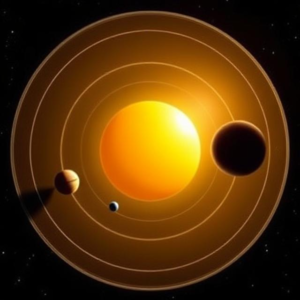Kepler’s Laws of Planetary Motion:
Kepler’s Laws describe the motion of planets around the Sun. They were discovered by Johannes Kepler in the early 1600s, based on detailed observations of the planets made by Tycho Brahe. These laws help us understand how planets move in their orbits and explain a lot about the way our solar system works.
There are three main laws, and they describe the shape, speed, and timing of planetary orbits.

1. Kepler’s First Law: The Law of Ellipses
- What it says: Planets move in elliptical orbits with the Sun at one of the two foci (focus points) of the ellipse.
- What is an ellipse? An ellipse is like a stretched-out circle. It’s not a perfect circle, but a squished or elongated one. So, planets don’t move in perfect circles; their paths are more like ovals.
- Key idea: The Sun is not at the center of the orbit; it’s at one of the two foci. If the orbit were circular, the Sun would be in the center.
- Simplified explanation: Imagine the planet’s path is like a slightly stretched circle (ellipse), and the Sun is located at one of the two focus points. The planet moves around it, sometimes closer to the Sun, sometimes farther away.
2. Kepler’s Second Law: The Law of Equal Areas
- What it says: A line drawn from a planet to the Sun (called a radius vector) sweeps out equal areas in equal amounts of time.
- What does this mean? This law tells us that a planet moves faster when it is closer to the Sun and slower when it is farther away. The area swept out by the line connecting the planet and the Sun is always the same over equal time periods, even though the planet’s speed changes.
- Key idea: When a planet is closer to the Sun (in the inner part of its orbit), it moves faster. When it’s farther away, it moves slower.
- Simplified explanation: Imagine you have a string attached to a pencil and a piece of paper. If you move the pencil fast while keeping the string tight, it will cover a large area quickly. If you move it slowly, it will cover less area in the same time. This is how planets move—faster when closer to the Sun, slower when farther away.
3. Kepler’s Third Law: The Law of Harmonies
- What it says: The square of the orbital period (the time a planet takes to complete one orbit around the Sun) is directly proportional to the cube of the semi-major axis (the average distance between the planet and the Sun).
- Formula:
Where:
is the orbital period (how long it takes to go around the Sun).
is the average distance from the Sun (the semi-major axis of the ellipse).
- What does this mean? If you compare two planets, the one that is farther from the Sun will take much longer to orbit than a planet that is closer to the Sun. The farther the planet, the longer it takes to go around the Sun, and the relationship between distance and time is fixed.
- Key idea: The larger the orbit, the longer it takes the planet to orbit the Sun. For example, Earth takes 1 year to orbit the Sun, but Neptune, which is farther away, takes 165 Earth years!
- Simplified explanation: If you know the distance a planet is from the Sun, you can predict how long it will take to orbit. The farther away the planet, the longer the orbit will take. The relationship is like this: if a planet’s distance is doubled, its orbit time is about 8 times longer.
Summary of Kepler’s Three Laws
- First Law (Law of Ellipses): Planets move in elliptical orbits, not circles. The Sun is at one focus of the ellipse.
- Second Law (Law of Equal Areas): A planet moves faster when it is closer to the Sun and slower when it is farther away. A line between the Sun and the planet sweeps equal areas in equal times.
- Third Law (Law of Harmonies): The time it takes a planet to orbit the Sun is related to its distance from the Sun. The farther the planet, the longer it takes to complete an orbit.
Real-World Examples
- Earth’s Orbit: Earth is about 93 million miles away from the Sun, and it takes about 365.25 days to complete one orbit.
- Neptune’s Orbit: Neptune is much farther away, at about 2.7 billion miles, and it takes 165 Earth years to orbit the Sun!
Why Are These Laws Important?
- They describe the motion of planets with great accuracy and are the foundation of modern astronomy and space exploration.
- These laws help scientists calculate the positions and movement of planets and other objects in space, allowing us to predict their locations years into the future.











